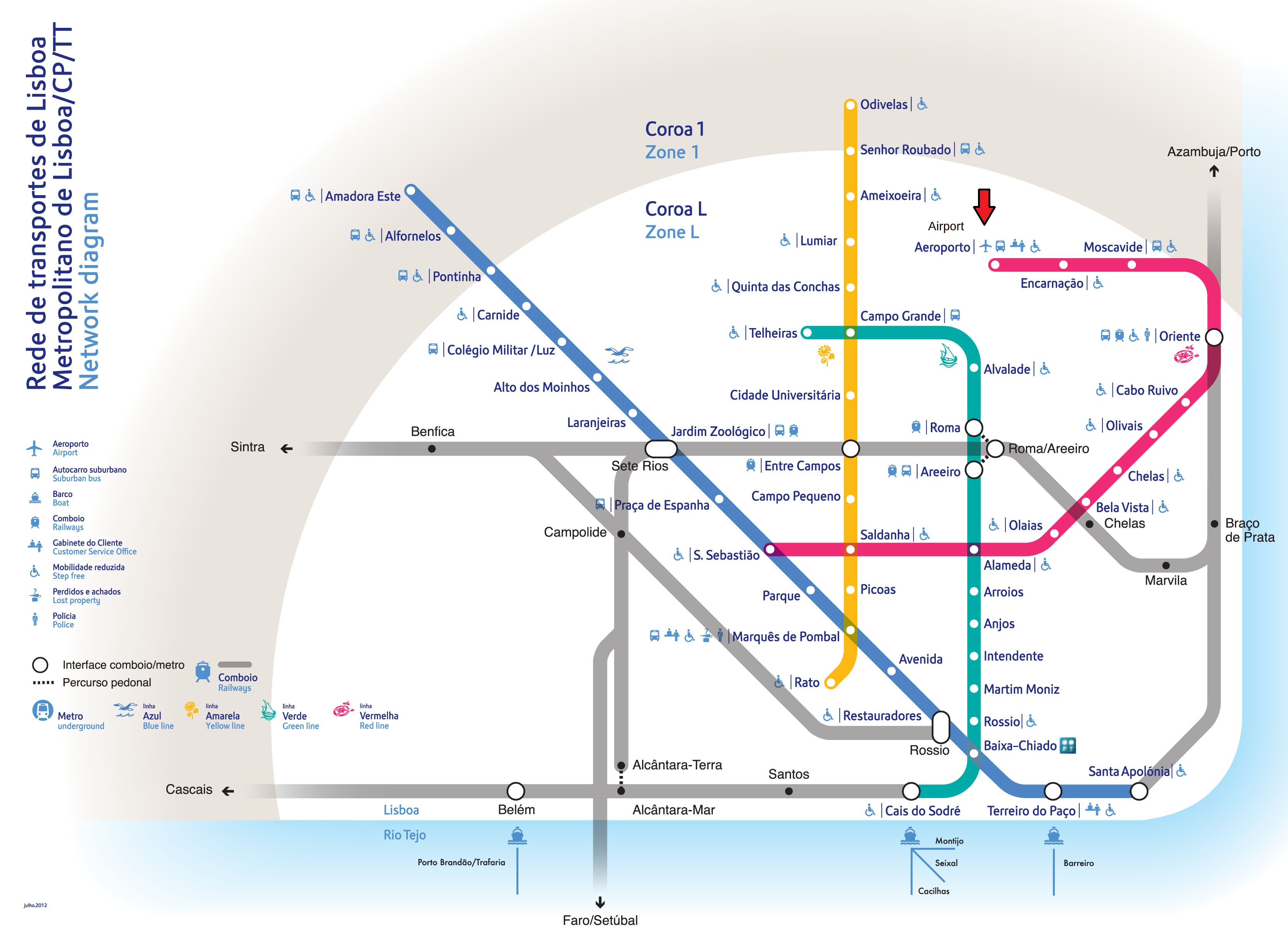
Picture it : the 1950s. Lisbon is already beautiful, but traffic’s on the rise and the city’s hilly geography makes some commutes… well, let’s say “cardio-friendly”! It’s in this setting that the idea of an underground metro began to take shape. Construction started on 7 August 1955, and four years later, the very first section of the Lisbon Metro was inaugurated ! Back then, it was a huge leap forward, a network that would slowly transform the way the Portuguese capital moves.
A bit of history (because who doesn’t love that)
The original system, shaped like a “Y”, connected Sete Rios (now Jardim Zoológico) to Restauradores via Rotunda (today’s Marquês de Pombal) and then on to Entrecampos.
Today, Lisbon’s metro stations aren’t just practical : some have become true little gems of architecture and art, a special nod to those decorated by artist Maria Keil in the early years.
How it works ? in real life
Okay, enough nostalgia, how do you actually use it when you arrive ?
The metro runs every day, including weekends : it opens around 6:30 a.m., and the last trains leave around 1 a.m. (from terminal stations).
You can buy your ticket (single ride or rechargeable card) at automatic machines inside the stations. There are also monthly passes available.
At the entrance, tap your card, walk through the gates, and voilà, your “journey begins” the moment you pass through !
By the way, on the official metro website, you’ll find maps, timetables and real-time updates super handy !

©lisbonne-idee
Useful tips to make your life easier
Download the official Lisbon Metro app (and/or any Lisbon transport app), you’ll have the network map, alerts, schedules and routes right in your pocket !
If you’re a tourist or a newcomer, stick to the main lines (Red, Blue, Yellow, Green), they cover the city centre and key areas.
Think about rush hours : like in every big city, mornings (8-10 a.m.) and evenings (5-7 p.m.) can get crowded.
Be ready for tunnels and slopes, Lisbon is hilly, and some stations are pretty deep or inclined.
If you’re carrying luggage or pushing a stroller, look for stations with lifts or ramps, accessibility info is available online.
Why I love it (and you probably will too)
Personally, I love taking the Lisbon Metro because it gives me that “I’m part of the city” feeling : you glide beneath the streets, skip the traffic, and get there fast. And it’s actually very clean (modern, for a network of its age) ; some stations are beautifully decorated ; and for expats or visitors, it’s the easiest way to explore Lisbon (just a few stops and boom, new scenery).
A few limits to keep in mind (because honesty first)
The metro doesn’t directly reach all the major tourist or popular areas (for example : historic neighbourhoods like Alfama or Belém aren’t that close to a station, but hey, a sunny walk never hurt anyone, and it’s good for you !)
Depending on where you stay, getting to the nearest station might mean a bit of an uphill or downhill walk (goodbye high heels !). And like everywhere, at night or in busy stations, keep an eye on your belongings and stay alert (it’s still the capital city, after all).
The Lisbon Metro is much more than a simple mode of transport : it’s a piece of history, a practical tool for living the city, and a daily (or occasional) travel companion. Whether you’re a local, an expat, or just visiting, using it with a bit of preparation (app, map, schedule) will save you time, energy and maybe even give you a few nice snapshots of your Lisbon life.
So next time you hear a train whistle echoing down the platform, think of it this way : you’re not just getting from A to B, you’re travelling through Lisbon’s history. Enjoy the ride !
Share this article
Suggested articles

Transport Cards (Viva Viagem, Andante) Explained
Travelling in Portugal also means learning how to move smoothly through its transport systems. In both Lisbon and Porto, two main cards rule the urban networks: Viva Viagem and Andante. Both appear simple, yet they can be confusing for newcomers. Here’s a clear guide to help you understand how they work and avoid common day-to-day mistakes.

Uber, Bolt & Taxis: How to Move Around Efficiently
Getting around Portugal has never been easier. Between traditional taxis, ride-hailing apps like Uber and Bolt, and local alternatives, the country offers a wide range of options to travel comfortably, whether you are a resident, tourist, or expat. But each solution has its advantages, fares, and particularities. Here’s a guide to understanding how to move around efficiently every day, from Lisbon to Porto, without stress.

Long-Distance Buses: Rede Expressos, FlixBus and Other Companies
Travelling by bus in Portugal has become, in recent years, a true alternative to trains or cars. Between national routes and international companies, the network is dense, efficient, and often very affordable. Rede Expressos, FlixBus, Alsa, and CitiExpress crisscross the country from north to south and also connect major European capitals. Here’s a guide to understanding how these companies work and why they appeal so much to travellers and expats alike.

TAP Air Portugal : the national airline between tradition and modernity
Picture this: you’re boarding a plane painted in Portugal’s colors, bound for Lisbon or Porto, and your adventure is already beginning! Because yes, choosing Portugal’s national airline isn’t just about the flag on the tail, it’s also (and above all) about history, a touch of Portuguese charm, and some surprisingly good opportunities. Here’s my little tour of TAP Air Portugal what you should know, why it’s worth considering, and a few insider tips to keep handy!

Ferries and Boats: Crossings in Lisbon, Algarve and the Azores
Portugal isn’t discovered only by road or rail. Bordered by the Atlantic Ocean and crossed by majestic rivers, the country also offers an extensive network of ferries and maritime connections linking cities, beaches, and islands.

Tram 28 in Lisbon : useful or tourist trap?
Ah, Tram 28… that little yellow tram winding its way through Lisbon’s narrow streets, wooden cabin, squeaky brakes, sharp turns… I’m pretty sure you’ve already seen it (at least in a photo!). But here’s the real question : is it truly a must-do, or just another tourist cliché to tick off before moving on ? Let’s talk about it, the highlights, the “watch out” moments, and how to really make the most of it.


